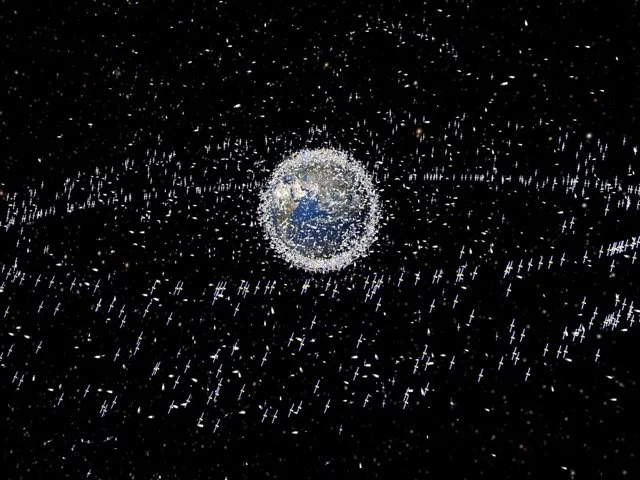Space Situational Awareness: Is the World Waking Up?
By Charles Law, Space Data Association
The recent case of the NASA toolbox accidently dropped by an International Space Station astronaut, has propelled the space situational awareness (SSA) issue into the mainstream headlines. With increasing numbers of satellites being deployed, particularly into LEO, and the growing problem of space debris, the SSA issue seems to at last be gathering momentum. To effectively tackle the challenge of increased space traffic and ever-increasing volumes of space debris, we need better SSA.
Although the issue is well known within the satellite industry, there has been a lack of urgency from government agencies. Having said that, European Space Agency (ESA), Global Space Operations Association (GSOA), and the Secure World Foundation (SWF) have each recently announced new SSA and debris mitigation initiatives. The question is are they true calls to action? Is the world waking up to the potential catastrophe looming above our heads?
The current landscape
Ensuring that space is safe and sustainable is obviously not a new concept. In order to protect space assets, satellite operators and other space users need to know where objects are in space, and where they’ll be next. It’s critical that space users are aware of any potential collisions so that they can take necessary precautions to avoid a collision and keep their assets safe. And as the number of objects in space is significantly increasing year on year, this is becoming more complex and indeed more important. The future sustainability of space relies on the world getting SSA right today, so that we can avoid further collisions and avoid adding to the problem. If we fail to do this, space will eventually become too unsafe to use.
There currently are many different systems being used, each with their own benefits and drawbacks, a situation where intergovernmental organisations and private companies have either established their own SSA systems, have adopted a commercial product or service such as those offered by COMSPOC, or have joined together with others to share data critical to the safety and integrity of the space environment via a platform such as the Space Data Association. These different approaches do not all use the same data or methodology to predict where objects will be so it’s not unusual for different outcomes to be reached. This is challenging to say the least because carrying out collision avoidance maneuverers can be costly, so it’s essential that the data is accurate, correct and in time to take the right decision. So, if the issue is so important, and the consequences of not getting it right are so substantial, for individual operators, the industry, and the world as a whole, then why is there such inertia?
Why the lack of meaningful action?
If we were blue sky thinking, all operators and space users would happily feed their ephemerides into a technically capable and sophisticated system, and this would generate accurate conjunction assessments. However, in reality, the situation is very different. Achieving effective SSA systems is an incredibly difficult task for a number of reasons, and it is these challenges that are all contributing to the problem.
Tracking objects and predicting trajectories with an acceptable level of accuracy is incredibly complex, not least because it requires aggregation of data from many sources, which carries its own challenges, but also because the available technology is limited in its ability to track very small pieces of debris. Additionally, agreements around data sharing tend to be difficult to obtain, either because of commercial sensitivities or because of political and security issues. And the conflicts and uncertainty that the world currently faces are only adding to the problem.
It’s difficult to get the buy-in of all stakeholders because not only are there a of lot space players to engage with, but there are also a lot different interests and agendas, many of which are competing with each other. And not only that, but if an organisation or operator has invested in doing SSA in a certain way, it’s quite difficult then to persuade them to alter their approach. A heavy-handed regulatory approach is most likely not the answer either because of challenges around sovereignty concerns, power imbalances and political issues. A firm regulatory approach may even have the opposite effect of what it is trying to achieve and result in states withdrawing from discussions and agreements entirely.
There is also the question of financial responsibility. The creation and maintenance of a comprehensive space object catalogue on the scale required comes with significant costs and effort. It’s critical that all stakeholders work collaboratively to minimise this cost and effort as much as possible. The sums of money needed to develop accurate systems are so huge that funding needs to be prioritised at government level. Without sufficient investment in SSA systems, their capability will remain limited.
Satellites Surrounding Earth, credit: ESA
Tackling the space debris issue
Yes, we need to develop better SSA systems, but we also need to focus attention on ensuring that we don’t continue to add to the debris problem. It’s essential that we take a no tolerance approach and ensure that all satellites are launched, managed and decommissioned carefully in order to leave no debris in active orbits. There is also a need to invest and develop removal techniques to try to deal with the debris already in orbit. This is important, not only because of the risk to flight safety if debris is left in active orbits, but also because if two pieces of orbital debris collide, this will create more debris which will only serve to compound the problem.
However, this is easier said than done because debris removal is challenging for a number of reasons. Locating and getting close to objects while they are moving at speed is technically and logistically complex, and requires state-of-the-art technology. And debris comes in a range of shapes and sizes - from spent rockets and defunct satellites, to small pieces of metal and even fragments of paint - so a single solution will not clearly work for all types of debris. Another barrier is funding because given the high costs and technical challenges involved, developing and implementing removal measures is enormously costly.
Despite these challenges, private companies and intergovernmental bodies are developing innovative approaches to debris removal using techniques such as harpoon systems, nets, tethers and robotics to capture large objects. ESA has commissioned the space mission, ClearSpace-1, to target the Vespa (Vega Secondary Payload Adapter) upper stage left in an approximately 800 km by 660 km altitude orbit after the second flight of ESA’s Vega launcher back in 2013. The mission is planned for launch in 2025, and will use robotic tentacles to grab the object, then both objects will deorbit together and burn up on the atmosphere. The UK space agency is also funding a debris removal mission to launch in 2026.
Alongside debris removal, intergovernmental agencies such as ESA are also looking at ideas for missions and systems that could be used to refurbish, manufacture, and recycle objects in orbit. In fact, ESA has ambitious aims to achieve a circular space economy by 2050 and currently has an open call for ideas to help achieve the aim.
Significance of the new initiatives
Let’s now turn our attention to look at the recent initiatives launched by ESA, GSOA and SWF around promoting SSA and the mitigation of space debris. The Zero Debris Charter launched by ESA is a hugely important development because it has been created collaboratively by a community of proactive space actors who are all dedicated to advancing space safety and sustainability. The charter contains both high-level guiding principles and specific and jointly defined targets to reach Zero Debris. The aim is to cease adding new debris to orbit by 2030. The fact that this charter is a collaborative effort is significant because it demonstrates both the commitment, and the will, among the space community to act. Organisations are currently being invited to register intent to sign the Zero Debris Charter and it is expected that signing ceremonies will take place in the first half of this year.
GSOA’s Code of Conduct on Space Sustainability is another major new initiative. It was released in November 2023 and aims to identify and endorse industry space sustainability practices that will enable the world to fully utilise space resources. The Code of Conduct calls on operators to endorse the space sustainability measures and recommended practices set out in the code, in order to mitigate the risk of in-orbit collision, minimise the threat of non-trackable debris, protect humans in space, and limit the effects on optical astronomy. The code is an important milestone towards safeguarding space resources.
Also released in November 2023, was SWF’s Space Industry Statement in Support of International Commitments Not To Conduct Destructive Anti-Satellite Testing. The statement, which is currently supported by thirty-six space industry players from eleven countries, demonstrates the industry wide commitment in protecting the long-term sustainability of the space environment. It builds on the commitment already made by several countries including the US, Canada, New Zealand, Japan, Germany, UK, and South Korea, to not to carry out ASAT tests. SWF’s Space Industry Statement is another important step along the road towards preserving the sustainability of space.
Also worth mentioning here is the decision made by EU SST to open its collision avoidance service to international users. Previously, the EU SST’s public collision service was available to EU member states only, but in January 2023, the service was opened up to allow owners and operators established outside of the EU to also register for the service. The decision to open up the service to owners and operators worldwide was made the 27 Member States of the European Union, along with European Parliament, Council of the European Union and European Commission, following Article 8 of the Regulation establishing the Union Space Programme.
The decision is significant for two reasons. Not only will it help to avoid a collision event and ensure a minimum level of safety in space by providing all owners and operators with access to a public collision avoidance service, but it also demonstrates a sense of shared responsibility to address the problem of keeping space safe and ensuring its use is sustainable.
Closing reflections
As a member of the SDA, I’ve often felt frustrated by the slow pace in improving the SSA issue. It’s true that operators have a responsibility to launch, manage, and decommission satellites without leaving debris, but the issue goes much wider than that. I think the initiatives outlined above highlight that the industry, and all wider stakeholders, are finally accepting that the issue of space debris and SSA is not just the role of individual operators but is instead a much broader issue that needs to be tackled collaboratively by different parts of the space ecosystem.
Although I’m encouraged by the recent initiatives by the likes of ESA, GSOA and SWF, and think we’re heading in the right direction, we clearly still have a long way to go. It’s important that the initiatives materialise into meaningful actions, otherwise very little will change, and we will start to see our worst fears around space safety and space sustainability start to come to fruition.
I believe we’re currently at a pivotal moment in history. We’re witnessing huge growth in space activity, but the SSA systems are not developing at the pace needed to mitigate the threats posed by space debris or to ensure the sustainability of space operations in the years to come. It’s critical that 'we' prioritise the development and implementation of effective SSA systems, invest in research and technology for debris removal, and establish collaborative frameworks for policy development and enforcement.

